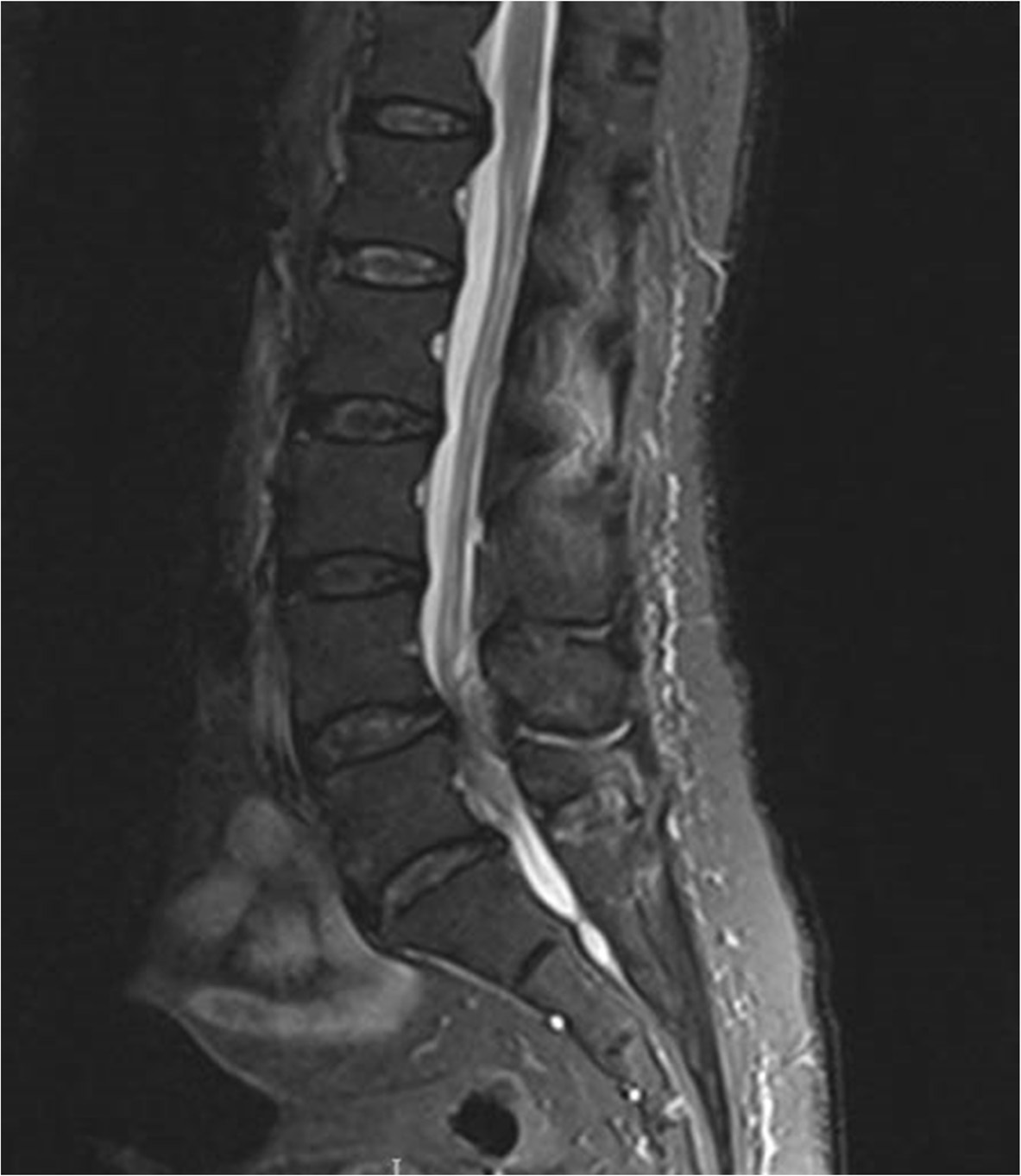Cauda equina syndrome (CES) is a neurosurgical emergency which occurs when there is compression of the cauda equina.
Pathophysiology
Occurs due to direct compression of the cauda equina. The spinal cord terminates into a structure called the conus medullaris, usually at the L1/L2 level. Distal to this is the cauda equina (Latin for tail of horse due to its appearance) - a bundle of nerves carrying the nerve roots for L2-S5 and the coccygeal nerve. Its function is critical:
- Motor: Innervation of the pelvic floor muscles, lower limbs and anal sphincter
- Sensory: Sensation around the perineum and lower limbs
- Autonomic: Provides parasympathetic supply to the bladder as well as to the pelvic organs i.e. reproductive organs and digestive organs.
Causes
- Lumbar disc herniation: Particularly at the L4/L5 or L5/S1 level
- Trauma: For example, from a fracture
- Spinal stenosis
- Primary malignancy
- Metastases
- Prostate
- Renal
- Lung
- Breast
- Thyroid
- Discitis
- Iatrogenic: For example, due to haematoma forming after spinal anaesthesia or lumbar puncture
Risk Factors
- History of disc herniation
- Heavy lifting
- Obesity
- Female
Clinical Features
- Lower back pain
- Bilateral sciatica: Can be unilateral or may begin as unilateral and progress to involve both legs. Bilateral sciatica is a red flag.
- Urinary retention: Due to disruption of autonomic nerves
- Saddle anaesthesia: Numbness or paraesthesia in the saddle region – asking patients if they can feel the toilet paper when they wipe their bottom is a good way of assessing this.
- Lower limb paraesthesia
- Lower limb weakness: Alongside other features of lower motor neuron disease such as hyporeflexia/areflexia.
- Bladder/bowel dysfunction: This can be in the form of urinary retention/constipation, or urinary/faecal incontinence.
- Reduced/loss of anal tone
- Sexual dysfunction: Erectile dysfunction or loss of vaginal sensation
Investigations
Bedside
- A full neurological exam checking the dermatomes and myotomes of the lower limbs specifically is extremely important with CES. Mostly lower motor neuron signs will be seen i.e., hypotonia/areflexia etc.
- Pre and post-void bladder scan: Important to assess for bladder dysfunction. Urinary retention is a red flag.
- Catheter tug: No sensation when a catheter is being tugged is another red flag.
- PR examination: There is some debate with regards to the value of a PR examination but it is essentially used to assess anal tone by asking the patient to squeeze, as well as perianal sensation.
Bloods
- FBC, U&E, CRP: Baseline
- Clotting screen: Pre-operative
- Group & save: Pre-operative
Imaging
- MRI Whole Spine: This is the mainstay of diagnosis.
- CT Myelogram: Sometimes done as an alternative to patients who are unable to have an MRI due to contraindications.
https://en.wikipedia.org/wiki/Cauda_equina_syndrome#/media/File:MRI_of_the_lumbar_spine_with_abscess_in_the_posterior_epidural_space,_causing_cauda_equina_syndrome.jpg
MRI demonstrating Cauda Equina syndrome
Differential Diagnosis
- Musculoskeletal pain: From strain of paraspinal muscles
- Radiculopathy: Occurs when there is disruption in spinal nerve/nerve root conduction. It results in weakness/paraesthesia/anaesthesia. Radicular pain can occur as a consequence of irritation of the spinal nerve tissue. This most commonly occurs secondary to nerve compression e.g. from a disc prolapse or from degenerative changes in the spine.
- Sciatica: ‘Shooting pain’ from buttock/lower back, down the back of the leg.
- Discitis: Should be suspected in patients with fever and raised inflammatory markers, particularly if there is a history of IVDU or immunosuppression.
Management
The mainstay of treatment is surgical decompression. This is often done via a laminectomy which involves removal of the lamina part of the vertebra, which enables decompression of the spinal cord.
References
https://www.ncbi.nlm.nih.gov/books/NBK537200/#:~:text=Cauda%20equina%20syndrome%20(CES)%20results,the%20L3%2DL5%20nerve%20roots.
https://spinal.co.uk/wp-content/uploads/2023/08/National-Suspected-Cauda-Equina-Pathway-February-2023-FINAL-V1-1.pdf
